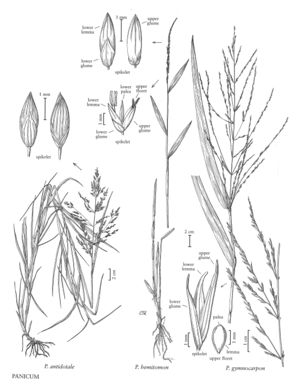Difference between revisions of "Panicum antidotale"
FNA>Volume Importer |
imported>Volume Importer |
||
| (4 intermediate revisions by 2 users not shown) | |||
| Line 4: | Line 4: | ||
|publications= | |publications= | ||
|common_names=Blue panicgrass | |common_names=Blue panicgrass | ||
| + | |special_status={{Treatment/ID/Special_status | ||
| + | |code=I | ||
| + | |label=Introduced | ||
| + | }} | ||
|basionyms= | |basionyms= | ||
|synonyms= | |synonyms= | ||
| Line 17: | Line 21: | ||
-->{{Treatment/Body | -->{{Treatment/Body | ||
|distribution=N.Mex.;Tex.;Utah;Calif.;Ala.;N.C.;S.C.;Pacific Islands (Hawaii);Ariz.;Fla. | |distribution=N.Mex.;Tex.;Utah;Calif.;Ala.;N.C.;S.C.;Pacific Islands (Hawaii);Ariz.;Fla. | ||
| − | |discussion=<p>Panicum antidotale is native to India. It is grown in the Flora region as a forage grass, primarily in the southwestern United States. It is now established in the region, being found in open, disturbed areas and fields.</p> | + | |discussion=<p><i>Panicum antidotale</i> is native to India. It is grown in the Flora region as a forage grass, primarily in the southwestern United States. It is now established in the region, being found in open, disturbed areas and fields.</p> |
|tables= | |tables= | ||
|references= | |references= | ||
| Line 26: | Line 30: | ||
-->{{#Taxon: | -->{{#Taxon: | ||
name=Panicum antidotale | name=Panicum antidotale | ||
| − | |||
|authority=Retz. | |authority=Retz. | ||
|rank=species | |rank=species | ||
| Line 33: | Line 36: | ||
|basionyms= | |basionyms= | ||
|family=Poaceae | |family=Poaceae | ||
| − | |illustrator=Linda A. Vorobik | + | |illustrator=Linda A. Vorobik;Cindy Roché |
| + | |illustration copyright=Utah State University | ||
|distribution=N.Mex.;Tex.;Utah;Calif.;Ala.;N.C.;S.C.;Pacific Islands (Hawaii);Ariz.;Fla. | |distribution=N.Mex.;Tex.;Utah;Calif.;Ala.;N.C.;S.C.;Pacific Islands (Hawaii);Ariz.;Fla. | ||
|reference=None | |reference=None | ||
|publication title= | |publication title= | ||
|publication year= | |publication year= | ||
| − | |special status= | + | |special status=Introduced |
| − | |source xml=https:// | + | |source xml=https://bitbucket.org/aafc-mbb/fna-data-curation/src/200273ad09963decb8fc72550212de541d86569d/coarse_grained_fna_xml/V25/V25_1289.xml |
|subfamily=Poaceae subfam. Panicoideae | |subfamily=Poaceae subfam. Panicoideae | ||
|tribe=Poaceae tribe Paniceae | |tribe=Poaceae tribe Paniceae | ||
Latest revision as of 18:56, 11 May 2021
Plants perennial; cespitose, rhizomatous, rhizomes about 1 cm thick, knotted, pubescent, with large, scalelike leaves. Culms 50-300 cm tall, 2-4 mm thick, often compressed, erect or ascending, hard, becoming almost woody; nodes swollen, glabrous or pubescent; internodes glabrous, glaucous. Sheaths not keeled, shorter than or equal to the internodes, glabrous or the lower sheaths at least partially pubescent, hairs papillose-based; ligules 0.3-1.5 mm; blades 10-60 cm long, 3-20 mm wide, elongate, flat, abaxial surfaces and margins scabrous, adaxial surfaces occasionally pubescent near the base, with prominent, white midveins, bases rounded to narrowed. Panicles 10-45 cm, to 1/2 as wide as long, open or somewhat contracted, with many spikelets; branches 4-12 cm, opposite or alternate, ascending to spreading; pedicels 0.3-2.5 mm, scabridulous to scabrous, appressed to diverging less than 45° from the branch axes. Spikelets 2.4-3.4 mm long, 1-1.3 mm wide, ellipsoid-lanceoloid to narrowly ovoid, often purplish, glabrous, acute. Lower glumes 1.4-2.2 mm, 1/3 – 1/2 as long as the spikelets, 3-5-veined, obtuse; upper glumes and lower lemmas subequal, glabrous, 5-9-veined, margins scarious, acute; lower florets staminate; upper florets 1.8-2.8 mm long, 0.9-1.1 mm wide, smooth, lustrous, acute. 2n = 18, 36.
Distribution
N.Mex., Tex., Utah, Calif., Ala., N.C., S.C., Pacific Islands (Hawaii), Ariz., Fla.
Discussion
Panicum antidotale is native to India. It is grown in the Flora region as a forage grass, primarily in the southwestern United States. It is now established in the region, being found in open, disturbed areas and fields.
Selected References
None.
